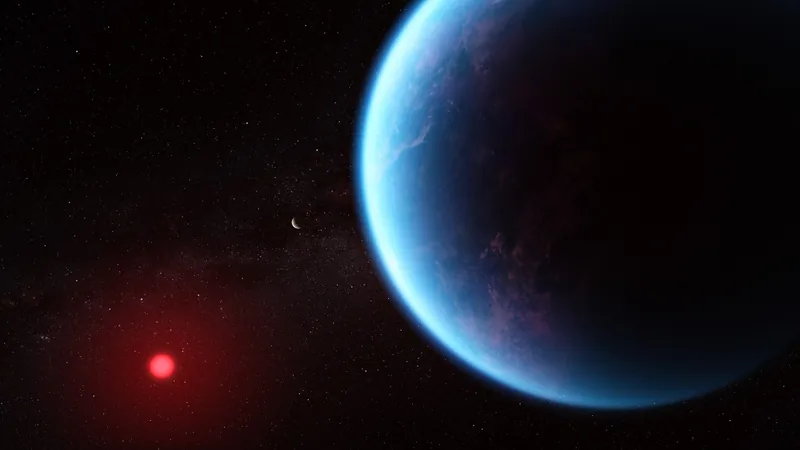
Scientists Skeptical Over Claims of Life on Exoplanet K2-18b: The Hints Aren't Strong Enough!
2025-05-25
Author: Lok
Skepticism Surrounds Exciting Findings on K2-18b
In a captivating turn of events, scientists from Cambridge University raised eyebrows in 2023 when they announced possible signs of life on K2-18b, a temperate sub-Neptune exoplanet dwelling a whopping 124 light-years from Earth. The excitement was fueled by NASA's James Webb Space Telescope (JWST) allegedly detecting features that suggested a liquid water ocean and potentially, life!
The buzz intensified with claims of detecting dimethyl sulfide (DMS), a molecule solely produced by marine life here on Earth. This sparked hopes that K2-18b could be a 'Hycean world' teeming with life, but now, it seems there's more to the story — and not all of it is promising.
The Debate Rages On
Astrophysicists aren't all on board with the initial excitement over the DMS detection. Critics argue that the evidence remains shaky. Rafael Luque, a postdoctoral researcher at the University of Chicago, emphasized that the reliability of this supposed biosignature is in question. Instruments can yield conflicting results, leading to what Luque aptly called 'two different stories' about the same planet.
In a recent preprint study, Luque and his colleagues examined the original claims and found the purportedly 'strong' signals of DMS to be considerably weaker when analyzed alongside previously collected data from other JWST instruments.
Combining Data for Clarity
The team combined observations from three key JWST instruments to arrive at a more cohesive interpretation of K2-18b’s atmospheric spectrum. Caroline Piaulet-Ghorayeb, another researcher on the team, explained that the supposed strong signs of DMS were merely insignificant hints, even possibly misleading.
“We found that when integrating various datasets, the originally claimed stronger signal diminished significantly,” Piaulet-Ghorayeb noted, highlighting the importance of cross-checking and verifying data.
A Complex Atmosphere Presents Challenges
Detecting molecules in distant exoplanets is no simple feat. Spectral analysis reveals unique 'fingerprints' based on how an atmosphere absorbs starlight, but similarities between certain molecules can complicate matters. Piaulet-Ghorayeb warns that distinguishing between DMS and ethane, for example, is challenging due to their nearly identical structures.
“We must be cautious not to misinterpret these signals as signs of life,” she cautioned, echoing the larger concerns among the astronomical community.
The Importance of Responsible Reporting
The 2023 study characterized the DMS detection as 'tentative,' yet the latest 2025 paper claimed it reached a statistical significance level that many think is exaggerated. Luque argues that if careful scrutiny isn't applied, scientists risk inflating the evidence for claims about extraterrestrial life.
“As Carl Sagan wisely stated, 'extraordinary claims require extraordinary evidence.' We haven’t met that threshold yet,” Luque said.
The Future of K2-18b Research
Will we ever uncover the truth about life on K2-18b? It appears uncertain. Even with ongoing observations from JWST, detecting signs of life may further prove elusive. However, there's hope that we will learn more about the planet’s atmosphere and interior in future analyses.
For now, while the idea of life beyond Earth remains tantalizing, scientists remind us to approach these claims with a healthy dose of skepticism.




 Brasil (PT)
Brasil (PT)
 Canada (EN)
Canada (EN)
 Chile (ES)
Chile (ES)
 Česko (CS)
Česko (CS)
 대한민국 (KO)
대한민국 (KO)
 España (ES)
España (ES)
 France (FR)
France (FR)
 Hong Kong (EN)
Hong Kong (EN)
 Italia (IT)
Italia (IT)
 日本 (JA)
日本 (JA)
 Magyarország (HU)
Magyarország (HU)
 Norge (NO)
Norge (NO)
 Polska (PL)
Polska (PL)
 Schweiz (DE)
Schweiz (DE)
 Singapore (EN)
Singapore (EN)
 Sverige (SV)
Sverige (SV)
 Suomi (FI)
Suomi (FI)
 Türkiye (TR)
Türkiye (TR)
 الإمارات العربية المتحدة (AR)
الإمارات العربية المتحدة (AR)